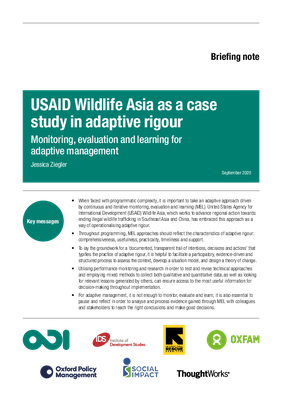USAID Wildlife Asia as a case study in adaptive rigour: monitoring, evaluation and learning for adaptive management
The Global Learning for Adaptive Management (GLAM) initiative looks at how the United States Agency for International Development (USAID) Wildlife Asia programme has operationalised the concepts of adaptive rigour and adaptive management as part of its approach to collaborating, learning and adapting. As described by the Global Learning for Adaptive Management (GLAM) initiative, adaptive rigour is about ensuring that the data, information, methods, processes and systems that underpin adaptive management are robust, systematic and high‑quality. Featured at: https://www.odi.org/publications/17351-usaid-wildlife-asia-case-study-adaptive-rigour-monitoring-evaluation-and-learning-adaptive
Key messages
- When faced with programmatic complexity, it is important to take an adaptive approach driven by continuous and iterative monitoring, evaluation and learning (MEL). USAID Wildlife Asia, which works to advance regional action towards ending illegal wildlife trafficking in Southeast Asia and China, has embraced this approach as a way of operationalising adaptive rigour.
- Throughout programming, MEL approaches should reflect the characteristics of adaptive rigour: comprehensiveness, usefulness, practicality, timeliness and support.
- Utilising performance monitoring and research in order to test and revise technical approaches and employing mixed methods to collect both qualitative and quantitative data, as well as looking for relevant lessons generated by others, can ensure access to the most useful information for decision-making throughout implementation.
- For adaptive management, it is not enough to monitor, evaluate and learn; it is also essential to pause and reflect in order to analyse and process evidence gained through MEL with colleagues and stakeholders to reach the right conclusions and make good decisions.
You can download the briefing note at: https://www.usaidwildlifeasia.org/news/all-news/odi-ml-mel4am-usaidwildlifeasia-bn-sep20-final.pdf/view


